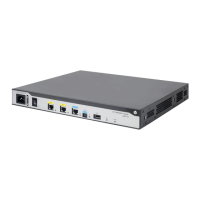190
SYN Cookie can protect the server from SYN Flood attacks. When the server receives a SYN packet,
it responds with a SYN ACK packet without establishing a TCP semi-connection. The server
establishes a TCP connection and enters ESTABLISHED state only when it receives an ACK packet
from the client.
To enable TCP SYN Cookie:
Step Command Remarks
1. Enter system view.
system-view
N/A
2. Enable SYN Cookie.
tcp syn-cookie enable
The default setting is disabled.
Configuring the TCP buffer size
Step Command Remarks
1. Enter system view.
system-view
N/A
2. Configure the size of TCP
receive/send buffer.
tcp window
window-size
The default buffer size is 64 KB.
Configuring TCP timers
You can configure the following TCP timers:
• SYN wait timer—TCP starts the SYN wait timer after sending a SYN packet. Within the SYN
wait timer if no response is received or the upper limit on TCP connection tries is reached, TCP
fails to establish the connection.
• FIN wait timer—TCP starts the FIN wait timer when the state changes to FIN_WAIT_2. If no
FIN packet is received within the timer interval, TCP terminates the connection. If a FIN packet
is received, TCP changes the connection state to TIME_WAIT. If a non-FIN packet is received,
TCP restarts the timer, and tears down the connection when the timer expires.
To configure TCP timers:
Step Command Remarks
1. Enter system view.
system-view
N/A
2. Configure TCP
timers.
• Configure the TCP SYN wait timer:
tcp timer syn-timeout time-value
• Configure the TCP FIN wait timer:
tcp timer fin-timeout time-value
By default:
• The TCP SYN wait timer is 75
seconds.
• The TCP FIN wait timer is
675 seconds.
Enabling sending ICMP error messages
Perform this task to enable sending ICMP error messages, including redirect, time exceeded, and
destination unreachable messages.
• ICMP redirect messages
A host that has only one default route sends all packets to the default gateway. The default
gateway sends an ICMP redirect message to inform the host of a correct next hop by following
these rules:
{ The receiving and sending interfaces are the same.

